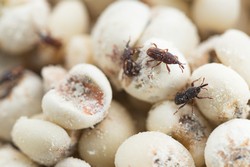The tick-tock of the evolutionary molecular clock
Many biological processes in human development and disease are under the control of molecular clocks including the rhythmical formation of somites during vertebrate embryogenesis. Blocks of tissue, somites, give rise to vertebrae and associated muscle. The ARTHROPODSEGCLOCK project has investigated the segmentation clock in insects and vertebrates using the red flour beetle Tribolium castaneum. Previous work by a project researcher had revealed striking similarities in the way this insect makes its trunk segments and how vertebrates (including humans), make their internal reiterated structures, such as vertebrae and associated muscles. Results indicate how the gene network controlling segment formation in insects may have been modified during insect evolution. Transition from Tribolium-like sequential segmentation to Drosophila-like simultaneous segmentation most likely involved changes in the temporal order. This involved the expression of key developmental genes and corresponding switches in the direction of regulatory interactions between these genes. Also identified were three conserved factors that control the segmentation process in both Drosophila and Tribolium at the time of development. Mediating changes in the way key segmentation genes interact at different stages of the segmentation process, researchers compared the two groups. Results suggest that shifts in the spatiotemporal pattern played a major role in the transition from sequential to simultaneous segmentation in insects. Increasing the significance of these three factors further is that they play a role in formation of the developing body axis in vertebrates. Working backward along the evolutionary timeline, it is likely that they have been inherited from a common ancestor that lived more than 500 million years ago. Furthermore, results indicate that the temporal factors are part of the Tribolium wavefront that converts the temporal information in molecular oscillations of the segmentation clock into the spatial pattern of the segments. This situation is analogous to a vertebrate wavefront that gives rise to segments but uses a different set of genes. ARTHROPODSEGCLOCK research results have increased the knowledge base on evolution of animals. Tribolium has been established as a powerful model for the study of molecular clocks.
Keywords
Evolutionary, molecular clock, ARTHROPODSEGCLOCK, Tribolium, sequential segmentation

